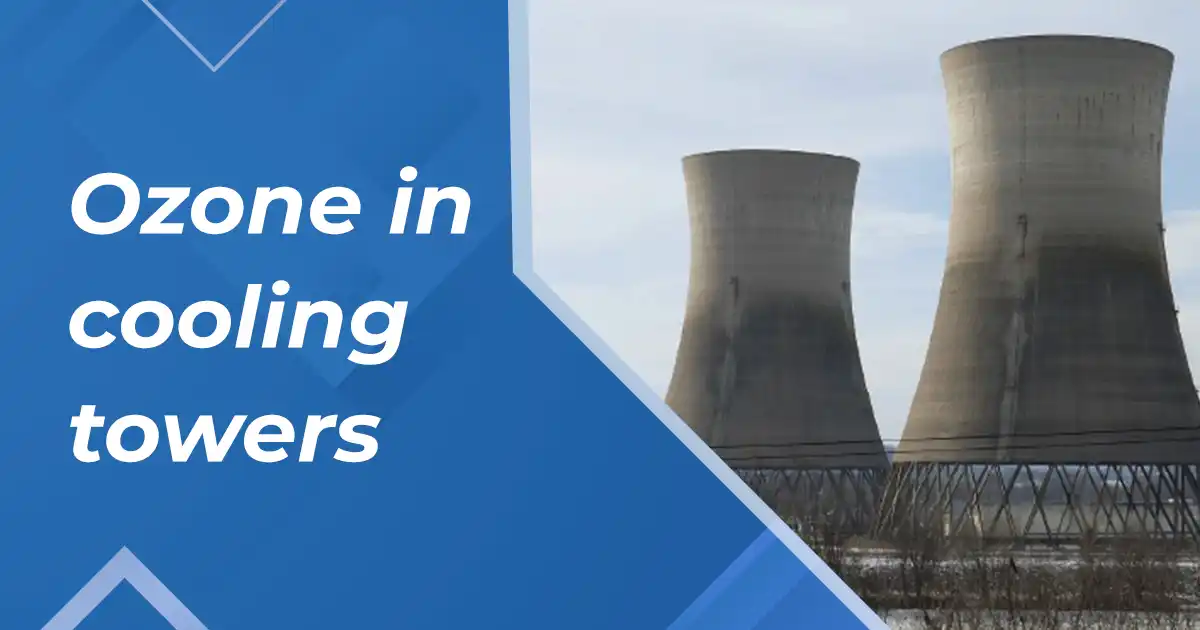Ozone in cooling towers


Ozone has been applied to industrial cooling water systems all around the world with phenomenal success. The result: improvement in operational efficiency due to increased heat transfer, reduced system corrosion, improved environmental impact and reduced on-going chemical expenditure
The aim of this paper is discuss the Chemistry involved in Cooling Tower Ozonation that often helps understands the process for successful implementation.
O 3 is the strongest oxidizing agent for water treatment.. By virtue of its properties Ozone is also the strongest disinfectant. The Electro Potential of various known oxidizing agents ( Table 1 ) shows that Ozone has a potential of around 2.07 and only second fluorine. Fluorine being very difficult to manage and Hydroxyl free radicals can only be produced by chemical reactions, Ozone becomes the strongest Oxidizing agent.
TABLE 1
Redox potentials of oxidizing biocides
Fluorine + 3,06 V
Hydroxyl Free Radicals + 2,80 V
Ozone + 2,076 V
Hydrogen Peroxide + 1,776 V
Permanganate + 1,679 V
Hypochlorous Acid + 1,482 V
Hypobromous Acid + 1,331 V
Hypochlorite Ion + 0,810 V
Hypobromite Ion + 0,761 V.|
Unlike the use of Ozone in Water treatment, The use of Ozone in Cooling Towers provides a challenge to the water treatment expert. Cooling Water being a re-circulation type, many chemical parameters are to be considered for the successful use of Ozone In cooling Towers.
Consider the following actions of Ozone:
Ozone exists in water in two forms . The Molecular ozone, and the Hydroxyl Form. While Molecular ozone is a very strong disinfectant agent, the hydroxyl group is a strong oxidizing agent. The proportion of the two forms can be altered by altering the pH of the water. In alkaline pH, the proportion of OH free radicals are higher. For example in pH of 9 , very little molecular ozone is detected in the water.
Carbonate and Bi carbonate anions are excellent scavengers of hydroxyl free radicals. Combined with this if the pH is also very high, the addition of ozone results in little benefit. Hydroxyl Free radicals are very short lived in the water. Carbonates anions are more than 25 times more effective hydroxyl free radical scavengers
Water is a universal solvent and is natures greatest corrosion agent ! It is only the presence of alkalinity in the water that prevents corrosion by water. Thus the alkalinity proportion in the cooling tower water and the pH are to be to controlled for effective ozonation and to prevent corrosion. Conversely the higher the concentration of carbonate ions, coupled with sufficient concentrations of calcium ion, the more will be the CaCO3 precipitation during Cooling tower operation. The more precipitation of CaCO3 means decrease in alkalinity levels which leads to increased Corrosion.
Organic materials react rapidly with Ozone, but are not always converted completely to CO2 and water. Organic such as aromatics, chlorinated organic some low weight acis etc react very slowly with Ozone. Presence of high Hydroxyl free radicals allows more complete oxidation of the organic.
Most of these ozone end products are aldehydes, ketones, carboxilic acids ( weak) and mixture of Aldehydes and keto – acids. Some of these are converted to CO2 and water by Hydroxyl free radicals. The formation of CO2 can cause an initial fall in pH and can increase the formation of carbonate ions and as calcium ions build up in water ( make up water and evaporation loss) calcium Carbonate precipitation can take place if the concentrations surpass the solubility level.
Therefore the some important factors in Ozonation of Cooling Tower water are PH, Alkalinity, amount and type of organic and inorganic materials present in the cooling tower water , and the method of application of ozone. These will alone determine the residual ozone at different locations of the cooling tower water.
The expected residual ozone in different locations of the cooling tower water are:
Cooling tower basin 0.025 to 0.250 ppm
Recirculating pump inlet 0.075 to 0.150 ppm
Heat exchanger inlet 0.040 to 0.080 ppm
Return line to tower 0.010 to 0.040 ppm
Cooling Tower problems:
Cooling Tower systems are subject to bio fouling problems as a result of micro-organisms from the surrounding environment. The bio fouling causes 3 major problems
1.Creates non- turbulent regions for crystal development (scaling),
2. Harbours anaerobic bacteria producing corrosion
3. Harbours patogens such as the bacterium legionella pneumophilia.|
Scale formation is due to the increasing concentration of hardness salts as a result of the re cycling of salts present in the system make up water due to the evaporation of “pure” water from the cooling circuit.
They are also prone to corrosion due to corrosion factors and also microbilogically induced corrosion due to iron and sulpur bacteria present in the system.
For optimum performance of cooling Tower the above problems must be minimized, the heat transfer surfaces maintained in a clean condition, corrosion controlled to maintain system integrity and microbial activity controlled to prevent the build-up of biofilm and proliferation of legionella bacterium.
Traditional methods that utilize a chemicals and biocides which, in themselves, also present other problems of storage and handling and potential environmental impact issues.
Cycles of concentration and Scaling under chemical treatment programme.
The degree of scale forming potential of a cooling water at differing cycles of concentration is the Langelier saturation Index (LSI). This index uses the calcium concentration (PPM CaCO3), alkalinity concentration (PPM CaCO3), TDS and temperature of the cycled-up cooling water to determine the maximum pH at which calcium carbonate will be not precipitate .
This is then compared to the actual pH of the cooling system which, if greater, will exhibit scale forming potential. Scale inhibitors are then dosed to retain calcium carbonate in solution at positive LSI ( LSI of say +3 can be achieved) and is controlled by system bleed to achieve the maximum cycles of concentration possible under the chemical treatment program..
In an ozone treated Cooling Tower the blow down is virtually zero and the cooling water is cycled up many more times, releasing calcium loss within the cooling system but also without the deposition of hardness scale on heat transfer surfaces. Calcium carbonate precipitates can be found in cooling tower sumps rather than on heat exchanger surfaces indicating the involvement of surface-active biopolymers. The probable explanation could be:
Oxidation products of biofilm and organic compounds act as chelatindg agents by forming bio-polymers, carboxylic acids and other organic compounds. Alginates, polysaccharides and other bio-polymers released are known to be surface active and may function as dispersants for suspended solids. This gives excellent corrosion inhibition within the cooling system probably due to the cathodic protection afforded by calcium carbonate. Thus the water conditions establish a non-corrosive environment.
Practical Ozone Scaling Index ( POSI )
POSI index gives the maximum conductivity at which the cooling tower can operate without scale formation.
Calcium is lost from solution this also leads to a reduction in the conductivity (TDS) of the cooling water – this is expected and allowed for in this index. This maximum conductivity can then be compare to the conductivity of the cooling tower make-up water to then determine the actual maximum concentration factor.
As this mechanism also provides corrosion protection it is important that the cycles of concentration are not allowed to go too low.
Maximum cooling water conductivity = 10 (1/log((Ca x Mg)/(Na + Cl))/log(Alk/10) x conductivity of make up water
Ca = Calcium hardness of make-up, ppm CaCO3
Mg = Magnesium Hardness of make-up, ppm CaCO3
ALK = Total alkalinity of make-up, ppm CaCO3
CI = Chlorides in make-up, ppm Cl
Na = Sodium in make-up, ppm Na
With ozonation it is possible to operate at cycles of concentration upto even 18 compared to the Normal of 5-6 under chemical treatment.
Retention time : This is the time the re circulating water spends within the Cooling Tower loop. It is obtained by dividing the Total quantity of water in the system with the Re-circulation flow rate and is normally expressed in minutes.
This will determine the Ozone dose and the residual ozone obtained. The Best-suited retention time will always be under 10 Minutes and if the retention time is more, than probably ozone injection methods are to be modified.
By Using an injector system we can achieve 95% mass transfer in a pressurized side stream strong water line which can be used to provide multi-point dosing around the tower system to ensure that the recommended Ozone levels are attained. The main dosage point being after the re-circulation pumps. Diffusers are also used to enhance Ozone mass transfer.
Care should be taken to ensure that the maximum recommended residual ozone concentrations are not exceeded. This is normally controlled by ORP indicators (Oxidation reduction Potential) . The OPR are normally not allowed to exceed 450 mV, in cooling tower waters, whereas in potable water, the levels are as high as 750mV.
Very low ORP indicates insufficient ozonation. Conversely low ozonation levels will increase the bio degradability of organic that will enhance bacterial proliferation and increase Bacterial counts.
COST BENEFITS:
Very often Ozone systems are considered very expensive when compared to the normal Chemical treatment process. Ozonation provides the following benefits, not all of them can be readily quantified in terms of savings.
Ozonation offers the following benefits:
A.. Quantified savings
Reduced Blow Down and Savings in water
Total chemical savings in most cases
Reduced cost for treating blow down water for Discharge. ( environmental impact)
Reduced cost for pretreatment of make up water water. ( disinfection)
Lower break down Costs
Lower maintenance costs.
B. Unquantified Savings:
Lower Cooling water temperature -More efficient Heat transfer – Reduced power costs.
Lower condenser operating pressures –
Longer life of cooling Towers
Reduces incidence of Legionella infections – Social obligations.
No inventory costs of chemicals and associated administrative costs
For a typical 4000 Tonne Cooling Tower the following savings could accrue :
*** Technical Director , Of Ozone Technologies and Systems India Pvt. Limited , Chennai.


